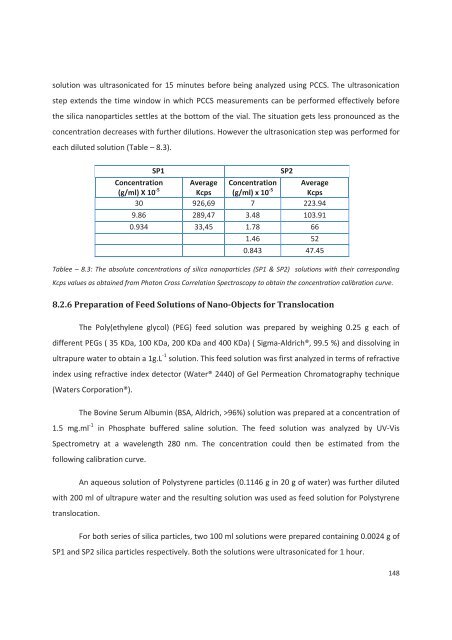4(%3)3 - Ecole nationale supérieure de chimie de Montpellier
4(%3)3 - Ecole nationale supérieure de chimie de Montpellier
4(%3)3 - Ecole nationale supérieure de chimie de Montpellier
Create successful ePaper yourself
Turn your PDF publications into a flip-book with our unique Google optimized e-Paper software.
solution was ultrasonicated for 15 minutes before being analyzed using PCCS. The ultrasonicationstep extends the time window in which PCCS measurements can be performed effectively beforethe silica nanoparticles settles at the bottom of the vial. The situation gets less pronounced as theconcentration <strong>de</strong>creases with further dilutions. However the ultrasonication step was performed foreach diluted solution (Table – 8.3).SP1SP2Concentration Average Concentration Average(g/ml) X 10 -5 Kcps (g/ml) x 10 -5 Kcps30 926,69 7 223.949.86 289,47 3.48 103.910.934 33,45 1.78 661.46 520.843 47.45Tablee – 8.3: The absolute concentrations of silica nanoparticles (SP1 & SP2) solutions with their correspondingKcps values as obtained from Photon Cross Correlation Spectroscopy to obtain the concentration calibration curve.8.2.6 Preparation of Feed Solutions of Nano-Objects for TranslocationThe Poly(ethylene glycol) (PEG) feed solution was prepared by weighing 0.25 g each ofdifferent PEGs ( 35 KDa, 100 KDa, 200 KDa and 400 KDa) ( Sigma-Aldrich®, 99.5 %) and dissolving inultrapure water to obtain a 1g.L -1 solution. This feed solution was first analyzed in terms of refractivein<strong>de</strong>x using refractive in<strong>de</strong>x <strong>de</strong>tector (Water® 2440) of Gel Permeation Chromatography technique(Waters Corporation®).The Bovine Serum Albumin (BSA, Aldrich, >96%) solution was prepared at a concentration of1.5 mg.ml -1 in Phosphate buffered saline solution. The feed solution was analyzed by UV-VisSpectrometry at a wavelength 280 nm. The concentration could then be estimated from thefollowing calibration curve.An aqueous solution of Polystyrene particles (0.1146 g in 20 g of water) was further dilutedwith 200 ml of ultrapure water and the resulting solution was used as feed solution for Polystyrenetranslocation.For both series of silica particles, two 100 ml solutions were prepared containing 0.0024 g ofSP1 and SP2 silica particles respectively. Both the solutions were ultrasonicated for 1 hour.148











